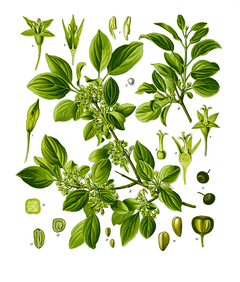- Rhamnus cathartica
-
Rhamnus cathartica 
Common buckthorn Scientific classification Kingdom: Plantae Division: Magnoliophyta Class: Magnoliopsida Order: Rosales Family: Rhamnaceae Genus: Rhamnus Subgenus: Rhamnus Species: R. cathartica Binomial name Rhamnus cathartica
L.Rhamnus cathartica (Buckthorn, Common Buckthorn or Purging Buckthorn), is a species in the family Rhamnaceae, native to Europe, northwest Africa, and western Asia, from the central British Isles south to Morocco, and east to Kyrgyzstan.[1][2] It was introduced to North America as an ornamental shrub in the early 19th century or perhaps before.[3][4]
Contents
Description
Rhamnus cathartica is a deciduous shrub or small tree growing up to 10 m tall, with grey-brown bark and spiny branches. The leaves are elliptic to oval, 2.5–9 cm long and 1.2–3.5 cm broad; they are green, turning yellow in autumn, and are arranged somewhat variably in opposite to subopposite pairs or alternately. The flowers are yellowish-green, with four petals; they are dioecious and insect pollinated. The fruit is a globose black drupe 6–10 mm diameter containing two to four seeds; it is mildly poisonous for people, but readily eaten by birds, which disperse the seeds in their droppings.[5][6]
Cultivation
The Common Buckthorn, Rhamnus cathartica, is shade-tolerant, moderately fast-growing and short-lived. This species is a tough, durable tree which adapts to urban or suburban environments, and virtually any area it is dispersed in. It is widely regarded as a major invasive species whose shade prevents the establishment of native trees or shrubs. It has become the target of efforts to eradicate it from home sites, parks and woodland areas. It is difficult to control because it sprouts vigorously and repeatedly from the root collar following cutting, girdling, or burning,[7] though it can be controlled by applying concentrated herbicide to the cut stem.
The species was originally named by Linnaeus as Rhamnus catharticus, but this spelling was corrected to cathartica as the genus name Rhamnus is of feminine gender.[8]
Cultivation and uses
The bark and fruit were used as a purgative in the past, though their potentially dangerous violent action and side effects means they are now rarely used.[9]
The wood is hard and dense, but little-used.
It is a food plant of the Brimstone butterfly. The sulphur-yellow males are indicative of the plant's presence.
This species is the alternate host for the important rust disease of cerals caused by Puccinia coronata. R. cathartica is also the primary overwintering host in North America for an important agricultural pest of soybeans, the soybean aphid.[10]
Invasive species - North America
The species is naturalised and sometimes invasive in parts of North America.[2][11][12] R. cathartica has a competitive advantage compared to native trees and shrubs in North America because it leafs out before native species.[13] Soil in woodlands dominated by R. cathartica was higher in nitrogen, pH, and water content that soil in woodlands relatively free of R. cathartica,[14][15] probably because R. cathartica has high levels of nitrogen in its leaves and these leaves rapidly decompose.
R. cathartica is also associated with invasive European earthworms (Lumbricus sp.) in the northern Midwest.[16] Removing R. cathartica led to a decrease of invasive earthworm biomass of around 50%. [17]
References
- ^ Flora Europaea: Rhamnus cathartica
- ^ a b Germplasm Resources Information Network: Rhamnus cathartica
- ^ Torrey J (1824) A flora of the northern and middle sections of the United States: or, a systematic arrangement of all the plants hitherto discovered in the United States north of Virginia. vol 1. T. and J. Swords, New York, pp. 513
- ^ Possessky S, Williams C, Moriarty W ((2000)). "Glossy Buckthorn, Rhamnus frangula L.: a threat to riparian plant communities of the northern allegheny plateau (USA).". Nat Area J 20:290–292.
- ^ Rushforth, K. (1999). Trees of Britain and Europe. Collins ISBN 0-00-220013-9.
- ^ Flora of NW Europe: Rhamnus cathartica
- ^ Barnes, Burton V. and Wagner Jr., Warren H. (2004) Michigan Trees ISBN 978-0-472-08921-5
- ^ Bean, W. J. (1980). Trees and Shrubs Hardy in the British Isles 8th ed., vol. 3. John Murray ISBN 0-7195-2427-X.
- ^ Plants for a Future: Rhamnus cathartica
- ^ Ragsdale D, Voegtlin D, O’Neil R ((2004)). "Soybean aphid biology in North America.". Ann Entomol Soc Am 97:204–208.
- ^ Minnesota Department of Natural Resources: Buckthorn - Invasive Species
- ^ Kathleen S. Knight, Jessica S. Kurylo, Anton G. Endress, J. Ryan Stewart, Peter B. Reich. "Ecology and ecosystem impacts of common buckthorn (Rhamnus cathartica): a review". Biol Invasions (2007) 9:925–937. http://www.cedarcreek.umn.edu/biblio/fulltext/t2041.pdf.
- ^ Barnes WJ (1972) The autecology of the Lonicera · bella complex. Dissertation, University of Wisconsin
- ^ Heneghan, L., Rauschenberg, C., Fatemi, F., Workman, M., 2004. European buckthorn (Rhamnus cathartica) and its effect on some ecosystem properties in an urban woodland. Ecol. Restor. 22 (4), 275–280
- ^ Liam Heneghan, Farrah Fatemi, Lauren Umek, Kevin Grady, Kristen Fagen, Margaret Workman. "The invasive shrub European buckthorn (Rhamnus cathartica, L.) alters soil properties in Midwestern U.S. woodlands". Applied Soil Ecology 32 (2006) 142–148. http://www.plantbio.ohiou.edu/epb/instruct/ecolunch/Heneghan%20et%20al.%202006.pdf.
- ^ Heneghan L, Steffen J, Fagen K ((2007)). "Interactions of an introduced shrub and introduced earthworms in an Illinois urban woodland: impact on leaf litter decomposition.". Pedobiologia 50:543–551.
- ^ Michael D. Madritch and Richard L. Lindroth. "Removal of invasive shrubs reduces exotic earthworm populations". Biol Invasions (2009) 11:663–671 DOI 10.1007/s10530-008-9281-7. http://www.univet.hu/users/pszabo/teaching/oak/4_adag/Madritch_Lindroth2009.pdf.
External links
 Media related to Rhamnus cathartica at Wikimedia Commons
Media related to Rhamnus cathartica at Wikimedia Commons- Biological and Control Information from the Invading Species Awareness Program Invading Species.com
- Information and Resources on Common Buckthorn in Ontario Most Unwanted - Common Buckthorn
Categories:- Rhamnus
- Flora of the Mediterranean
- Flora of Europe
- Flora of Northern Africa
- Flora of the Middle East
- Flora of Asia
- Flora of Morocco
- Flora of the United Kingdom
- Butterfly food plants
- Invasive plant species in the United States
- Medicinal plants
Wikimedia Foundation. 2010.
